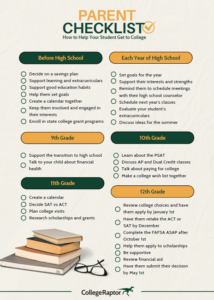Grades are important to getting accepted into a college, but that’s not all that goes into the process! Students also need a support system in order for them to succeed. Parents can absolutely help their children prepare for their future education through the entire college planning process. This checklist can help you and your family make the important decisions for college.
Download the FREE Parents College Planning Checklist PDF here
How Parents Can Help in College Planning
Before High School
 Decide on a savings plan. The earlier you start saving for college, the better. Parents have quite a few options when it comes to opening savings plans for their future college students, including ROTH IRAs, 529 plans, savings accounts, education tax credits, ESA plans, and more.
Decide on a savings plan. The earlier you start saving for college, the better. Parents have quite a few options when it comes to opening savings plans for their future college students, including ROTH IRAs, 529 plans, savings accounts, education tax credits, ESA plans, and more.- Support learning and extracurriculars. Foster curiosity in your child. Get involved with their homework and learning. Get them involved in their community, sign them up for sports, or/and have them join clubs that relate to their interests. Be a champion for their interests.
- Support good education habits. Students are starting to learn what interests them and what doesn’t. This can lead to good and bad habits. Teaching your child about the importance of studying and perseverance will help them succeed in high school and open more college doors.
- Help them set goals. By assisting your child in setting goals, you can keep them motivated and engaged with their education. It also sets great habits for the future.
- Create a calendar together. Mark down important school dates in an academic planner and/or on a wall calendar. Communicate about assignments, homework, tests, and more. Help them study.
- Keep them involved and engaged in their interests. Passions change, and it’s okay if a student wants to drop an extracurricular they no longer enjoy for a different one. If they can’t choose, suggest ones that support their skills and interests.
- Enroll in state college grant programs. Some state college grant programs require students to enroll before they’ve even reached high school.
Each Year of High School
- Set goals for the year. These can be obtaining a certain GPA, taking challenging courses, learning a new skill, or completing a reading list.
- Support their interests and strengths. Help your child learn about their interests and strengths by taking personality quizzes or career worksheets. High school guidance offices should have these resources. This will help guide your student when choosing what classes to take and careers to consider.
- Remind them to meet with their high school counselor. Building a relationship with their counselor will help them. Their counselor will be an invaluable guide to scholarships, scheduling courses, exploring career paths, and applying to college. They can also ask for recommendations later if they have a personal, respectful relationship.
- Schedule next year’s classes. Always defer to your child’s choices when they’re selecting classes, but you can also provide advice on the best courses for their goals. Talk to them about the importance of academic rigor when applying to colleges, too.
- Evaluate your student’s extracurriculars. Do they enjoy what they’re involved in? If yes, how can they take on more leadership? If not, brainstorm new activities to try and discuss what was learned.
- Discuss ideas for the summer. Summer should absolutely be a time for relaxation, but students can also stay engaged by joining camps or other activities.
9th Grade
- Support the transition to high school. Beginning high school is a milestone. Students are probably excited and parents may be nervous – or vice versa. They could be headed to a new school and preparing for more responsibilities and independence. Freshman year is an excellent opportunity to start encouraging your child to be a well-rounded, exceptional student and gain an interest in college.
- Talk to your child about financial health. Don’t keep them in the dark for too long regarding the financial side of life. Involve them in budgeting, let them know how much things cost, and suggest that they start saving for college, too.
- Print out the freshman year college planning checklist for your child to get them started!
10th Grade
- Learn about the PSAT. The PSAT is a sort of “practice SAT.” Talk to your student about the exam, studying for it, and the importance of the test. They will likely take it through their high school. Talk about the PSAT and other exam prep
- Talk about paying for college. If you haven’t already had discussions about it, now is the time to review the options for paying for college with them. Let them know how much they saved, and start thinking about scholarships, grants, and loans.
- Make a college wish list together. With your student, start considering the aspects that appeal to them in a college. Let them know this isn’t written in stone and their wants and needs can change.
- Continue talking about career interests. Down the road, transferring colleges or switching majors can lead to more time in college and of course more costs. So talking about and researching career interest now can help your student down the road.
- Download your child’s sophomore college planning checklist.
11th Grade
Junior year may cause students and parents to feel a shift. This is a common time for college planning to hit full force. Follow this guide to help support your student and stay on track.
- Discuss AP and Dual Credit classes. Juniors in high school can often start taking Advanced Placement (AP) or dual credit classes through the local college. Talk to them about these options and how they can help the student save time and money, while also increasing their chances of a college acceptance letter
- Create a calendar. College planning can be overwhelming. By creating a planner or calendar dedicated to college planning, students and parents can keep on track of what they need to do in the coming months.
- Decide SAT vs ACT. Students should plan to take their first SAT or ACT during the second half of their junior year. Review the pros and cons of each test with them, get them study materials, and assist with studying.
- Plan college visits. Students often start visiting colleges in the second half of 11th grade and over the summer.
- Research scholarships and grants. Get a head start on these awards by using scholarship databases and investigating the grants your state offers. Some will require your student to do quite a bit of work beforehand. For example, Bright Futures in Florida comes with a volunteer requirement. It’s not something that can be applied to overnight.
- Download your child’s junior year college planning checklist.
12th Grade
- Review college choices and have them apply by January 1st. Now is the time for your student to decide on and apply to colleges. Go over the pros and cons of each school with them. Plan college campus visits. Talk to them about early decision and early application deadlines in November
- Have them retake the ACT or SAT by December. Students don’t have to take the ACT or SAT at all. But, taking it more than once can prove beneficial especially if they get a great score. For regular decision deadlines of January 1st, the SAT and ACT needs to be taken in December at the latest.
- Complete the FAFSA ASAP after October 1st. The Free Application for Federal Student Aid (FAFSA) comes available on October 1st each year. Complete it as soon as possible. Delaying could result in less financial aid.
- Help them apply for scholarships. Using scholarship databases, help them identify awards they qualify for. However, never complete the applications for them.
- Be supportive. College planning can be extremely stressful, especially as acceptance letters (and rejection letters) come rolling in. Be there for them during this time. Help them review their options.
- Review financial aid. Financial aid offer letters will come with acceptance letters in most cases. These can be confusing. Use a financial aid offer comparison tool to cut through the complex numbers and information.
- Have them submit their decision by May 1st. Deposits and decisions have to be in by May 1st. Help them complete paperwork necessary to enroll in their choice and accept admission at the college.
- Download your child’s senior year college planning checklist.
College Match Makes it Easy
So much goes into college planning, and parents’ support during this time can be truly beneficial for the student! This checklist can help you keep on top of the tasks ahead for everyone involved.
Sign up for College Match to help you and your favorite student find the best schools for their wants, needs, and goals. Check it out here.


